I don’t usually play much chess against the computer because I get sick of getting smashed every time, but one rainy day I had nothing better to do, so I started up Fritz 9 on my Pentium 4 3ghz notebook. The time controls were set to long play and I chose to play as white. Even though I know a few openings, I didn’t fancy testing my knowledge against the computer, so I turned off the programs opening book. Ok, you might say that massively weakens the programs strength, but take into consideration that I was also playing out of book after move 2 against a world champion program which was eating virtually all of my 3ghz cpu – you can estimate its strength to be around GM level.
I can’t play my natural attacking style against a computer, as the computer will always win in tactical positions, so I played a closed position game. This game is quite instructive – see how I slowly reduce black’s space, and eventually put the computer into a position where it has no counter play, and I am free to arrange my pieces to attack the queenside.
Me - Fritz 9 [D02]
1.d4 Nc6 2.Nf3 d5 3.g3 Bf5 4.a3 Nf6 5.Bg2 e6 6.0–0 Qd7 7.Nbd2 Bd6 8.c4 0–0 9.c5 Be7 10.b4 a6 11.Bb2 Rad8 12.Nh4 Bg4 13.h3 Bh5 14.g4 Bg6 15.Nxg6 hxg6 16.f4 Kh7 17.g5 Nh5 18.Kh2 Rh8 19.e3 a5 20.Nf3 Kg8 21.Ne5 Nxe5 22.dxe5 b6 23.Bd4 Rb8 24.Qc2 axb4 25.axb4 Qc6 26.Rfb1 b5 27.Ra5 Rh7 28.Rba1 Rh8 29.Ra7 Qd7 30.R1a6 Rc8 31.Rb6 Kh7 32.Bf1 Ra8 33.Bxb5 Rxa7 34.Bxd7 cxb6 35.c6 Bd8 36.Bc8 Bc7 37.Bb7 Ra3 38.Qb2 Ra4 39.b5 Kg8 40.Qb3 Rxd4 41.exd4 Nxf4 42.Qa4 Rxh3+ 43.Kg1 Ne2+ 44.Kf1 Nxd4 45.Qxd4 Rh1+ 46.Kf2 Rb1 47.Ba6 Rc1 48.Ke2 Rc4 49.Qa1 Re4+ 50.Kd3 Kh7 51.Qa3 Bxe5 52.Qe7 Rd4+ 53.Ke3 Re4+ 54.Kf2 Rf4+ 55.Kg2 Rg4+ 56.Kf1 Rf4+ 57.Ke2 Re4+ 58.Kd2 Rd4+ 59.Kc2 Rc4+ 60.Kb3 Rc3+ 61.Ka2 Rc2+ 62.Kb1 Rb2+ 63.Kc1 Rf2 64.c7 Bxc7 65.Qxc7 Rf1+ 66.Kd2 Rf2+ 67.Ke3 Rf5 68.Qxb6 Rxg5 69.Qc7 Rg4 70.b6 Rb4 71.b7 d4+ 72.Kd3 1–0
If you have Fritz you should be able to copy&paste the above by going to edit>copy&paste > paste game.
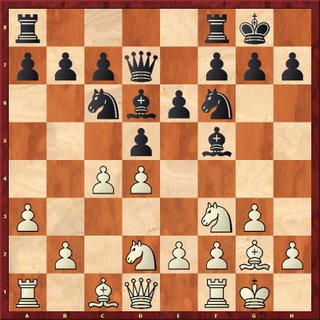
Here I played 9. c5 – This move keeps the position closed which reduces number of tactical threats, gains space on the queenside, and forces blacks pieces in the centre to become a bit squashed.
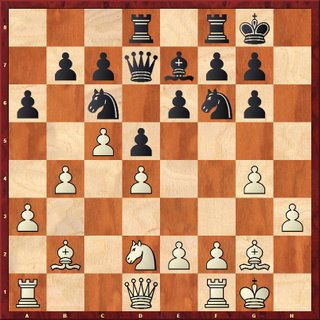
Here I play 16. f4 – this time gaining space on the kingside! – This game is all about reducing computers space to move.
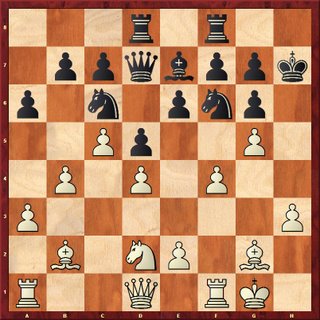
Here Fritz played 17…Nh5 – and for the next 23 moves that is where it remained! A terrific example of a bad knight.
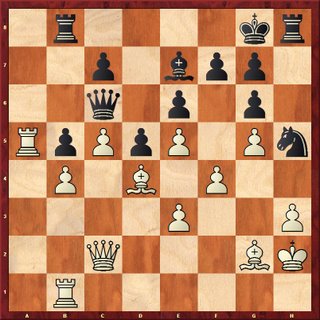
Here Fritz played 27…Rh7 - the computer is in such bad shape I’ve even managed to get it into playing nothing moves lol.
FINAL POSITION
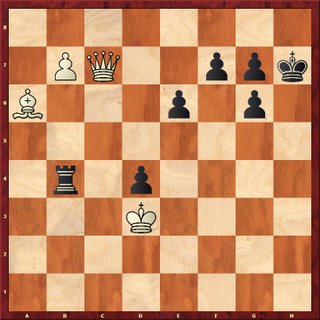
Fritz decided to resign at this point, but could have resigned many moves ago. A sweet victory against Fritz at last!
- Adding images and then editing the blog is a pain. Anyone know an easier way of working with blogger - recommend a blogger client maybe?